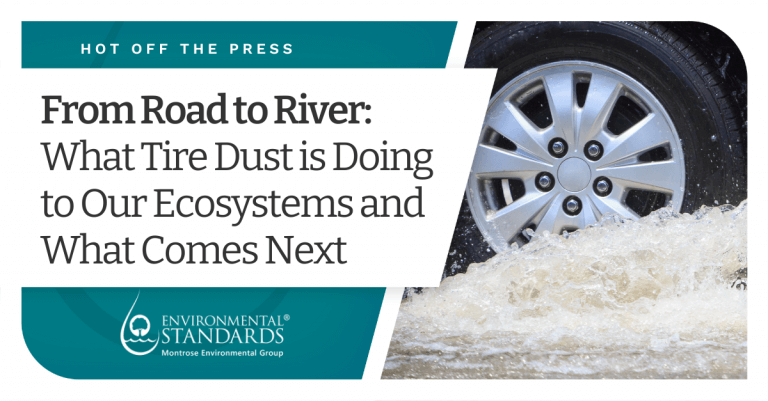

In The Standard’s December 2024 issue, the article “For Salmon, Tires May Be Just as Dangerous as Bears!” introduced a lesser-known environmental contaminant: 6PPD-quinone, a transformation product of the tire preservative 6PPD. This chemical, formed when tire particles interact with ozone, has been directly linked to acute mortality in coho salmon, threatening ecosystems and cultural traditions alike—particularly among tribal populations in the Pacific Northwest, which utilize the fish as a staple food source.
Now, with new regulatory guidance from the Interstate Technology and Regulatory Council (ITRC) and fresh insights from a recent webinar (view here), it’s clear that the fight against this emerging contaminant is gaining traction. But as any environmental professional knows, more information often raises more questions.
The Timeline of Toxicity: What We’ve Learned So Far
6PPD has been a standard anti-degradant in tires since the 1960s, but the first documented link between salmon mortality and roadway runoff didn’t occur until the 1990s. In 2011, widespread die-offs of coho salmon in the Puget Sound triggered deeper investigation. It wasn’t until 2020 that researchers definitively identified 6PPD-quinone as the cause.
This delay highlights a common challenge in environmental science: we often recognize the symptoms long before we understand the source. As the technology to detect low-concentration contaminants has improved, so too has our understanding of their impacts—not just on salmon, but potentially on other aquatic and terrestrial species, and even human health.
Where It’s Coming From—and Where It’s Going
Today, researchers agree that stormwater runoff is the primary pathway for 6PPD-quinone to enter waterways. Tire and road wear particles accumulate on road surfaces and are flushed into rivers and streams during rain events.
Ongoing research is expanding into soil, sediment, and air as potential reservoirs and transport pathways. Promisingly, early observations of biodegradation in soil suggest that natural attenuation may play a role in future mitigation. But to measure any of this accurately, sampling must be done with precision and care.
Sampling Smarter: Why Methodology Matters
Sound science starts with sound sampling. That’s especially true for a complex contaminant like 6PPD-quinone, which exists in multiple media—water, air, soil, and biota.
Sampling methods such as grab, automated, and passive collection each have strengths and limitations. Whether you’re developing a new monitoring program or refining an existing one, a well-structured sampling plan is essential to ensure data quality and representativeness. It’s also the first step toward compliance with future regulations.
The Methods Gap: Catching Up with the Contaminant
One of the biggest hurdles in managing emerging contaminants is the slow development of standardized testing methods. In January 2024, the U.S. Environmental Protection Agency (US EPA) released a draft method (1634) for measuring 6PPD-quinone in surface water using liquid chromatography with tandem mass spectrometry (LC-MS/MS).
While this draft marks important progress, it’s not yet finalized, and additional revisions are expected—similar to the long development of Method 1633 for PFAS (per- and polyfluoroalkyl substances). In the meantime, researchers and laboratories are relying on in-house or commercial methods to fill the gap.
Regulation in Motion: Tribal Advocacy and State Leadership
Change often starts from the ground up—and this case is no exception. In 2023, tribal nations petitioned the US EPA under TSCA Section 21 to classify 6PPD as a toxic substance. Their petition was granted, initiating new data requirements and chemical reporting obligations for manufacturers.
In December 2024, reporting requirements for health and safety studies were enacted. Meanwhile, Washington State has adopted aquatic life criteria for both 6PPD and 6PPD-quinone, using thresholds of 8.9 µg/L and 0.011 µg/L, respectively, to better protect freshwater species.
This patchwork of state-level action is setting the pace for eventual federal regulation—driven by public pressure, evolving science, and industry accountability.
What Can Be Done Today?
The ultimate goal is source control—finding safer alternatives to 6PPD altogether. But developing new anti-degradants that meet both chemical safety standards and federal motor vehicle safety regulations is a tall order. It will take time, research, and collaboration across sectors.
In the meantime, proven short-term strategies include:
- Stormwater management through green infrastructure and filtration systems
- Flow control to reduce peak runoff events
- Continued monitoring to track effectiveness and identify hotspots
These are not permanent fixes, but they buy time—and data—while better solutions are developed.
Leading the Way with Science and Strategy
As environmental consultants and technical experts, we recognize that contaminants like 6PPD-quinone require more than just curiosity—they demand rigor, planning, and long-term strategy. While the science is still evolving, we have enough clarity to act.
From designing defensible sampling plans to staying at the forefront of regulatory developments, we are committed to helping our partners navigate the challenges of emerging contaminants. The road ahead may be complex, but with the right tools and insights, we can protect the ecosystems—and communities—most at risk
Stay Informed. Stay Ahead
To explore the full ITRC guidance or watch the latest expert insights on 6PPD-quinone, visit the ITRC webinar archive. For support in sampling, assessment, or strategy, our team is ready to help you move forward with confidence.

